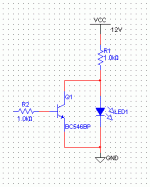10MBIT/s, not the fastest but they work, they´ll set the max switching freq to like 100KHz or so but as i only plan to drive subs, that is not a problem.
I think the 6N137 can also be used in a more linear mode that can enable the circuit to switch at higher frequencies. I have simulated such behavior and confirmed some linear action at low signal levels, but have not done much real life work with the idea.
Seriously, who needs a class d amp running @ 500KHz ? 
250KHz is enuf for even fullrange 😉
Btw fredos, @ which freq do your amps run ?

250KHz is enuf for even fullrange 😉
Btw fredos, @ which freq do your amps run ?
Heres a very crappy board that i cadded from the schemo.
I think i need a lession in routing boards
I think i need a lession in routing boards

An externally hosted image should be here but it was not working when we last tested it.
I revised the board, new pic:
An externally hosted image should be here but it was not working when we last tested it.
Update again:
An externally hosted image should be here but it was not working when we last tested it.
500Khz Idle go down to 250Khz at full output with PLL. 6N137 work very well at these frequency, but you have to drive it with shunt drivers.
Fredos
Fredos
Got an example of a shunt driver ? never used one.
I cannot use anythijng but what i have @ home so i hope it is something based on a transistor or something.
Actually i have never even heard of it. "shunt driver" on google gives plenty of hits but i have no clue what is what i would be looking for.
I cannot use anythijng but what i have @ home so i hope it is something based on a transistor or something.
Actually i have never even heard of it. "shunt driver" on google gives plenty of hits but i have no clue what is what i would be looking for.
A transistor that short the led at the place that a transistor that drive the led! Easy!
Fredos
Fredos
This sounds like shorting the LED to make it turn off faster, am i right ?
I understand it as this:
Or this:
Which is the right one ?
I understand it as this:
An externally hosted image should be here but it was not working when we last tested it.
Or this:
An externally hosted image should be here but it was not working when we last tested it.
Which is the right one ?
None! Simply feed power to the diode directly with a resistor, other side to your ground and put a transistor in parralelle that short the led to turn it off! Simple as this!
Fredos
Fredos
Bah sometimes one can be real stupid



Btw heres another board design for this thing:
Revisions are to come, as i have spotted things that can be made better. To tell the truth, i made this @ school today during a lession😱




Btw heres another board design for this thing:
An externally hosted image should be here but it was not working when we last tested it.
Revisions are to come, as i have spotted things that can be made better. To tell the truth, i made this @ school today during a lession😱

shunt driver
Hi edl,
Does it mean connecting the diode between pin 5 and pin 6 of 6N137?
Cheers,
K K
Hi edl,
Does it mean connecting the diode between pin 5 and pin 6 of 6N137?
Cheers,
K K
Heres a revised board:
Complaints ?
An externally hosted image should be here but it was not working when we last tested it.
Complaints ?

That's good EDL!
Tekko, the use of 7805 to power up the 6N137 will give you start up probleme. Dont use electrolitic too on the decoupling of the 6N137. At start up, the time to charge them will result in a shoot trought of your mosfet (inverting mosfet driver...). Only use small 0.1uF ceramic decoupling cap and a stupid 330 ohms 1/4W and 5.1V zener for regulation...That's experience. The way you do it will bring you lot of trouble.
Fredos
Tekko, the use of 7805 to power up the 6N137 will give you start up probleme. Dont use electrolitic too on the decoupling of the 6N137. At start up, the time to charge them will result in a shoot trought of your mosfet (inverting mosfet driver...). Only use small 0.1uF ceramic decoupling cap and a stupid 330 ohms 1/4W and 5.1V zener for regulation...That's experience. The way you do it will bring you lot of trouble.
Fredos
- Status
- Not open for further replies.
- Home
- Amplifiers
- Class D
- Breadboard Class D!!
